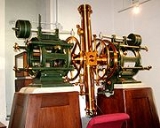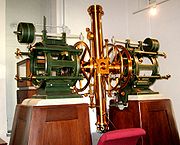
Transit instrument
Encyclopedia
In astronomy, transit instruments are used for the precise observation of star position
s. The instruments can be divided into three groups:

s in the exact direction of South or North:
The accuracy reaches from 0.2" (theodolites, small astrolabes) to 0.01" (modern meridian circles, Danjon). Early instruments (like the mural quadrants of Tycho Brahe
) had no telescope and were limited to about 0.01°.
Star position
Star position in the sky is defined by a pair of angles. These two angles - which refer to the celestial equator - are called declination and right ascension ....
s. The instruments can be divided into three groups:

Meridian instruments
for observation of star transitStar transit
A Star transit is the passage of a star through the eyepiece of an telescope.The precise observation of star transits is the basis of many methods in Astronomy and in Geodesy...
s in the exact direction of South or North:
- Meridian circleMeridian circleThe meridian circle, transit circle, or transit telescope is an instrument for observing the time of stars passing the meridian, at the same time measuring its angular distance from the zenith...
s, Mural quadrants etc. - Passage instruments (transportable, also for prime verticalPrime verticalIn astronomy and astrology, the prime vertical is the vertical circle passing east and west through the zenith, and intersecting the horizon in its east and west points....
transits)
Universal instruments
which allow transit measurements in anyone direction- Astronomical theodoliteTheodoliteA theodolite is a precision instrument for measuring angles in the horizontal and vertical planes. Theodolites are mainly used for surveying applications, and have been adapted for specialized purposes in fields like metrology and rocket launch technology...
s - Altaz telescopes with graduated eyepieces (also for satellite transits)
- CinetheodoliteCinetheodoliteA cinetheodolite is a photographic instrument for collection of trajectory data. It can be used to acquire data in the testing of missiles, rockets, projectiles, aircraft, and fire control systems; in the ripple firing of rockets, graze action tests, air burst fuze tests, and similar operations...
s
Zenith instruments and Astrolabes
- Zenith telescopeZenith telescopeA zenith telescope is a type of telescope that is designed to point straight up at or near the zenith. They are used for precision measurement of star positions, to simplify telescope construction, or both....
- Photozenith tube (PZT)
- zenith cameraZenith cameraZenith cameras are astronomic or geodetic instruments which are directed exactly to the zenith. The stars are recorded either by photographic plates or by CCD sensors.The main tasks in using these instruments are:...
s - Danjon astrolabeAstrolabeAn astrolabe is an elaborate inclinometer, historically used by astronomers, navigators, and astrologers. Its many uses include locating and predicting the positions of the Sun, Moon, planets, and stars, determining local time given local latitude and longitude, surveying, triangulation, and to...
, Zeiss Ni2 astrolabe, Circumzenital
Observation techniques and accuracy
Depending on the type of instrument, the measurements are carried out- visually and manual time registration (stopwatchStopwatchA stopwatch is a handheld timepiece designed to measure the amount of time elapsed from a particular time when activated to when the piece is deactivated. A large digital version of a stopwatch designed for viewing at a distance, as in a sports stadium, is called a stopclock.The timing functions...
, Auge-Ohr-Methode, chronographChronographA chronograph is a timepiece or watch with both timekeeping and stopwatch functions as well as other functions. Pocket watch chronographs were produced as early as the 18th century but did not become popular until the 1820s...
) - visually by impersonal micrometer (moving thread with automatic registration)
- photographic registration
- CCDCharge-coupled deviceA charge-coupled device is a device for the movement of electrical charge, usually from within the device to an area where the charge can be manipulated, for example conversion into a digital value. This is achieved by "shifting" the signals between stages within the device one at a time...
or other electro optic sensors.
The accuracy reaches from 0.2" (theodolites, small astrolabes) to 0.01" (modern meridian circles, Danjon). Early instruments (like the mural quadrants of Tycho Brahe
Tycho Brahe
Tycho Brahe , born Tyge Ottesen Brahe, was a Danish nobleman known for his accurate and comprehensive astronomical and planetary observations...
) had no telescope and were limited to about 0.01°.
See also
- Astronomical transitAstronomical transitThe term transit or astronomical transit has three meanings in astronomy:* A transit is the astronomical event that occurs when one celestial body appears to move across the face of another celestial body, hiding a small part of it, as seen by an observer at some particular vantage point...
- Position astronomy, Astrogeodesy
- latitudeLatitudeIn geography, the latitude of a location on the Earth is the angular distance of that location south or north of the Equator. The latitude is an angle, and is usually measured in degrees . The equator has a latitude of 0°, the North pole has a latitude of 90° north , and the South pole has a...
/longitudeLongitudeLongitude is a geographic coordinate that specifies the east-west position of a point on the Earth's surface. It is an angular measurement, usually expressed in degrees, minutes and seconds, and denoted by the Greek letter lambda ....
observation, vertical deflectionVertical deflectionThe vertical deflection at a point on the earth is a measure of how far the direction of the local gravity field has been shifted by local anomalies such as nearby mountains....
External links
- Karl RamsayerKarl RamsayerKarl Ramsayer was a German geodesist and is well known as one of the most important scientists in geodetic astronomy and in electronic navigation....
: Geodätische AstronomieGeodetic astronomyGeodetic astronomy is the application of astronomical methods into networks and technical projects of geodesy.The most important topics are:* Establishment of geodetic datum systems Geodetic astronomy is the application of astronomical methods into networks and technical projects of geodesy.The...
, Vol.2a of Handbuch der Vermessungskunde, 900 p., J.B.Metzler, Stuttgart 1969 - Cauvenet and Brünnow's Handbooks of Spherical Geodesy
- Transit instrument in the Encyclopedia.com
- Transit circle technique (Classic Encyclopedia)
- Great Transit at Lick Observatory, +Photo
- Modern roboter telescopes
- The Carlsberg Automatic Meridian Circle
- Photo of a 19 century Transit Instrument (Jones 1826)
- Transit instruments udes by the Survey of India, 1867)

